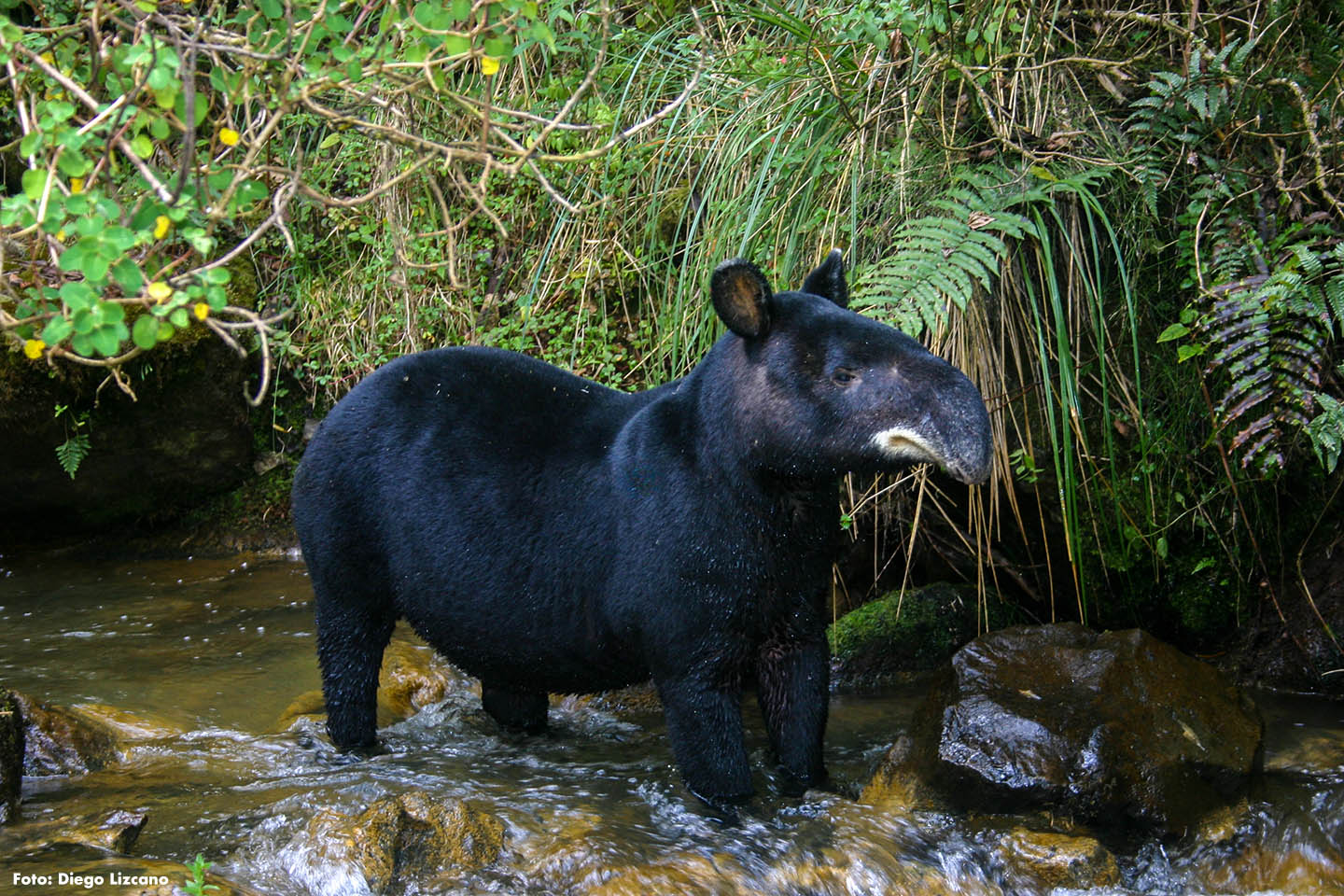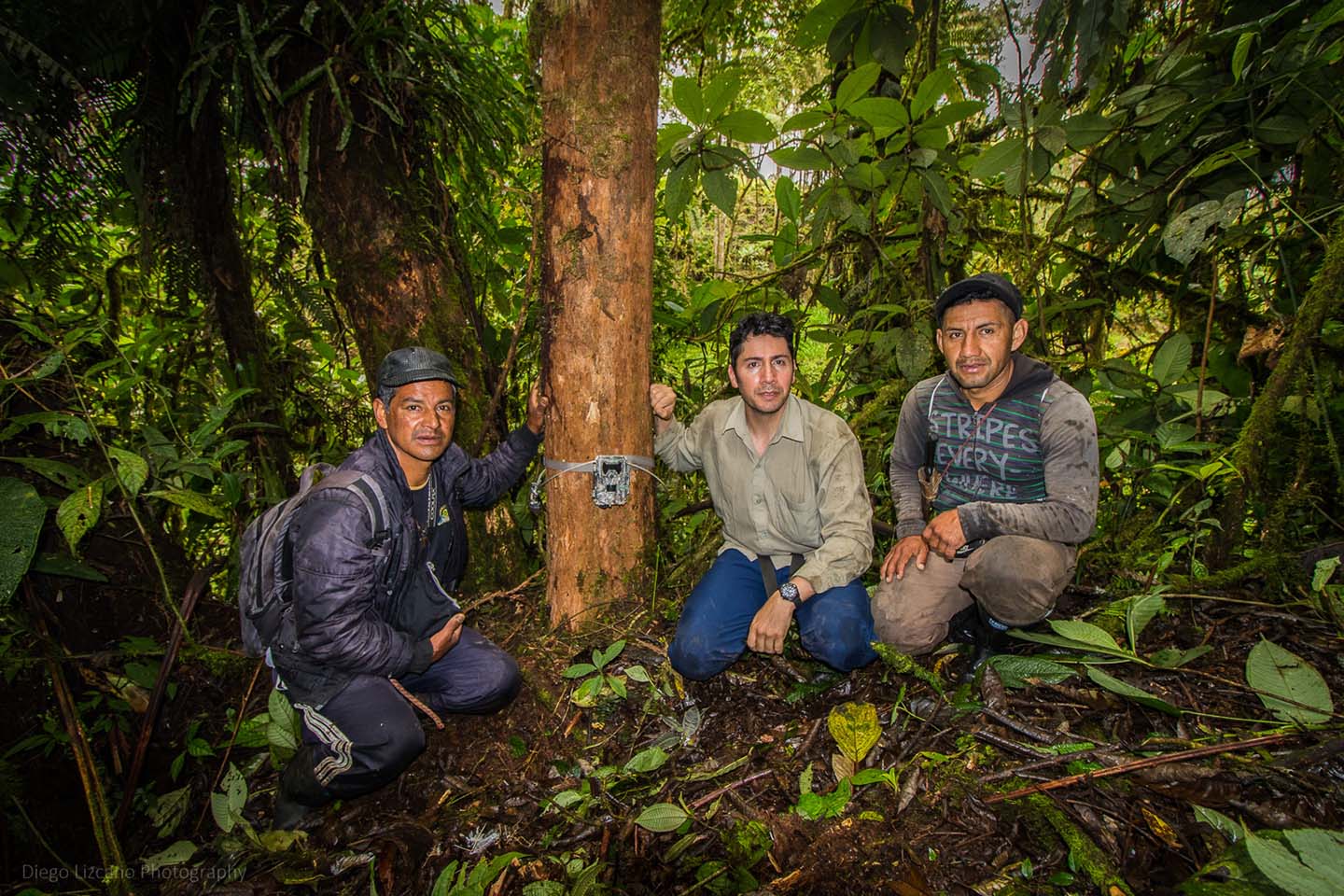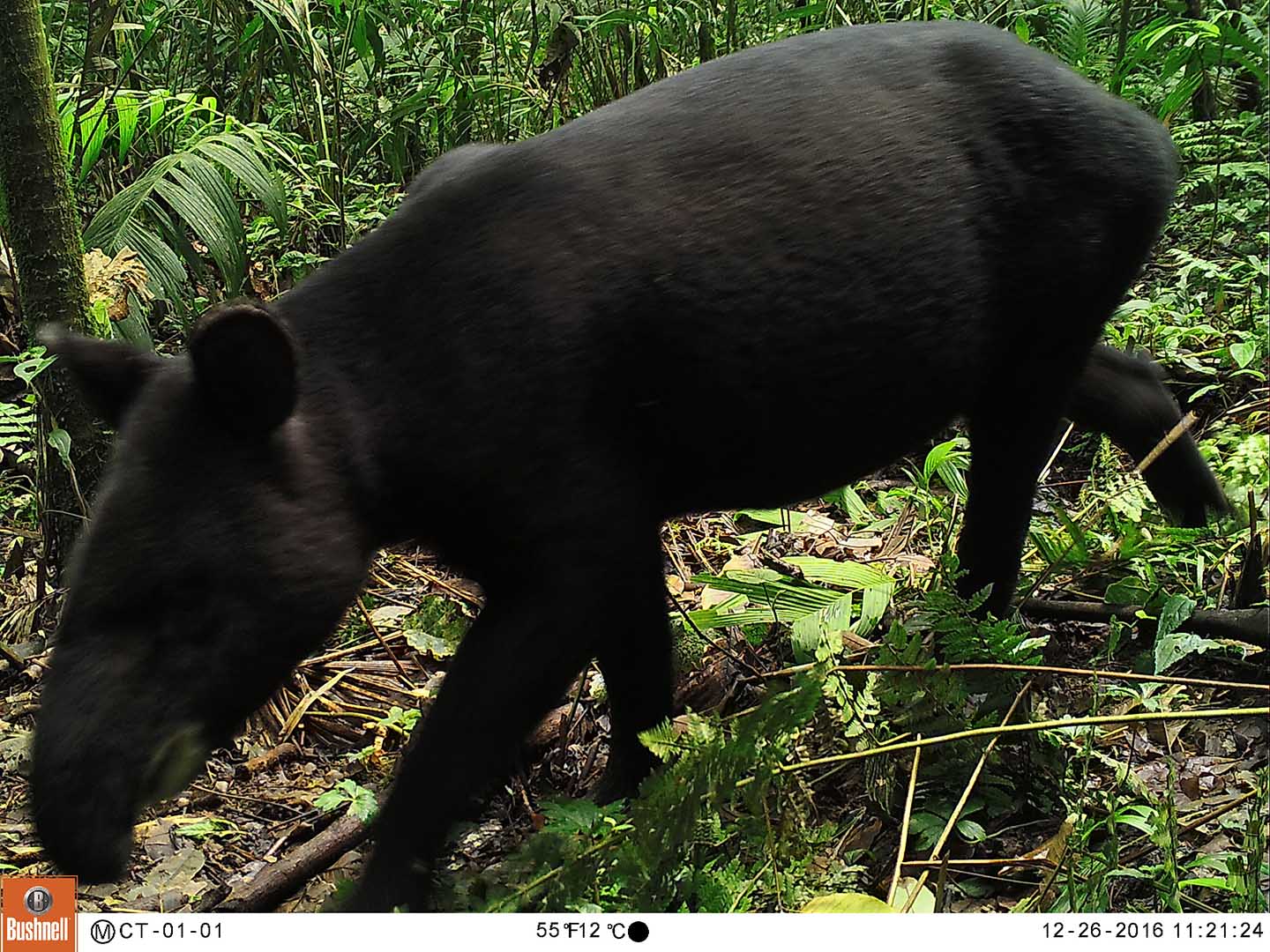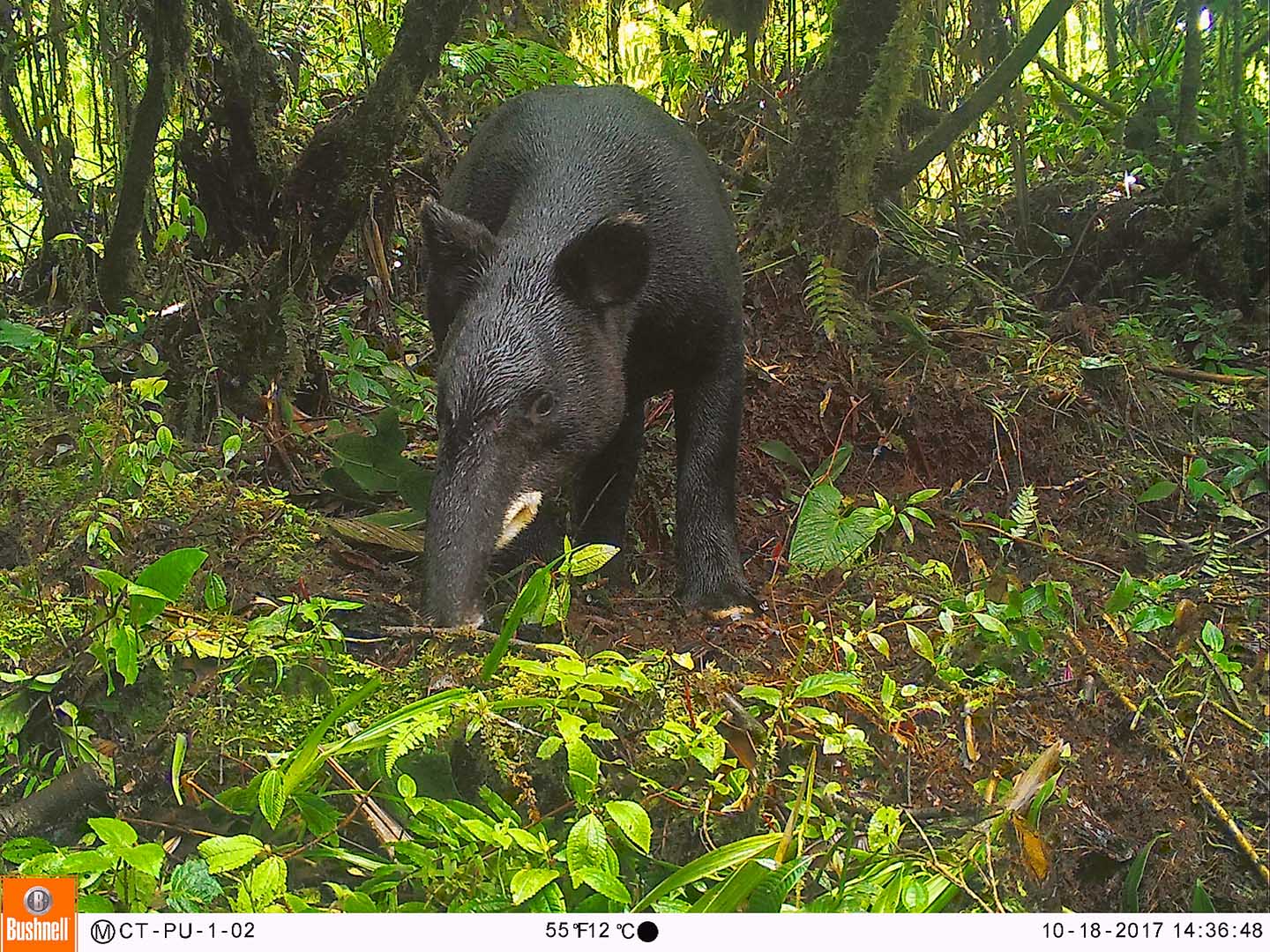Diego Lizcano is one of the best tapir experts, especially in the mountain tapir (Tapirus pinchaque), one of the three tapir species living in Colombia. This mammal silently regenerates the vegetation of paramos and Andean forests. It is endangered, says Diego, due to deforestation to make way for livestock farming.

There is a basic reason why all Colombians should protect the mountain tapir (Tapirus pinchaque): vegetation in the county’s Andean forests and paramos is renewed with its presence.
Mountain tapirs forage on many plants and, through their dungs, they disperse seeds from which new individuals sprout. They also eat huge amounts of introduced grasses that cover the ground and hinder the growth of native flora. They are adapted to support the natural regeneration of plants that we need in order to have food, fresh air and clear water.
Diego Lizcano, one of the Colombians that knows more about this mammal, describes it: as tall as a calf, as heavy as two robust jaguars, as brown as fertile soil and with a trunk that somehow reminds us of an elephant.

The mountain tapir, the lowland tapir (Tapirus terrestris) found in Orinoquia, and the Central American tapir (Tapirus bairdii) seen in Antioquia, Chocó and northern zones of the country, are the three tapirs recorded in Colombia, the only nation in the continent with three species.
After years of study and research, Lizcano is convinced that a key aspect of his work is conveying the environmental and scientific significance of this animal, unknown to the majority, as well as its strategic value, based on its silent work as a disciplined and inconspicuous gardener of the forest.
More because of the mountain than because of the tapirs
Diego studied biology at Universidad de los Andes. He initially thought he would work in the development of flora-based biotechnology projects. “But in my first ecology course, I was fascinated with animal ecology”, he remembers. It was the 1990 decade.
Life then led him, step by step, to his destiny as protector of the tapir. When the time came to write his thesis, and without a clear idea of what he wanted, he found an ad from a professor that offered research work in Risaralda with mountain tapirs. “I did not know much about them, but I liked to walk and explore and that project drew my attention more because of the mountain than because of the tapirs. But, luckily, I was hired for the research and spent almost eight months in the field looking for their traces and their footprints, for a count of their populations”.
He remembers that he did not see any tapirs, but finally had the certainty that he should dedicate his professional life to them.
Then came tracking work with camera traps, when these used camera film, and monitoring with satellite collars.
He did not forget the tapirs even when he travelled to England for his doctoral studies on biodiversity management at the University of Kent, which he completed in 2006. His thesis, although not focused on the tapirs, included them when he researched the effects on vegetation of the disappearance of big mammals due to hunting.

Lizcano was professor at the Universidad de Pamplona (Norte de Santander, Colombia) until 2012 and, in this position, had the opportunity to pursue his studies on tapirs with WCS Bolivia and in El Pantanal in Brazil. He then cooperated with the researchers of Conservation International (CI) and was researcher and professor at Universidad Laica Eloy Alfaro de Manabí (Uleam), in Ecuador. He is currently biodiversity specialist for the Northern Andes and South Central America Conservation Program of The Nature Conservancy (TNC), from where he promotes the protection of the species. Additionally, with Fundación Caipora - founded by biologist Silvia Álvarez, Lizcano's wife - he cooperates in the installation of camera traps in Risaralda, Quindío, Huila and Nariño to monitor the Andean tapir, another vernacular name for Tapirus pinchaque.
“With Silvia we say this is my week-end job”. And, although they do not invest many hours in this task, they have obtained registers of the presence of the mammal in the vicinity of the National Park Cueva de los Guácharos located between Caquetá and Huila, in the surroundings of Laguna de La Cocha, and in Cerro Patascoy (Nariño). Cerro Patascoy is a balcony in the Andes from which, with luck and sunny days, visitors can appreciate Colombia's Amazon Region extending to the south of its territory, including the course of the magnificent Putumayo River.
“The purpose of Fundación Caipora is the installation of camera traps in the Páramo de Sumapaz to clear up a doubt. The mountain tapir was described based on a skull found in this place but, since this discovery, there is no further register. We must admit that there has not been much research in the region due to public order issues, but we want to know if the tapir does form part of this landscape or if the person who discovered it erroneously associated it with Sumapaz.”
An increasingly degraded habitat
As per the International Union for Conservation of Nature (IUCN), Tapirus pinchaque is an ‘endangered’ species. Lizcano explains that this classification supports the fact that it has been hunted for years for its meat and sometimes as retaliation, when the tapir eats the leaves of the potato crops. But what most affects it is its habitat loss.

“We know that logging has concentrated in the Amazon and has partially dropped in some parts of the Andean Region, where several areas have self-regenerated. If the construction of La Línea tunnel is completed, we would have connection advantages and opportunities to construct biological corridors between national parks such as Los Nevados and Las Hermosas-Gloria Valencia de Castaño. But we cannot deny that the home of the tapir has been devastated, mainly due to the influence of the coffee plantations and logging to make way for livestock farming”, comments Diego. Cows eat the same plants as tapirs, which creates a harmful competition.
“Currently, only 15 percent of the habitat of mountain or Andean tapirs is covered by National Parks or National Protected Areas. Therefore, the great majority lives outside of these zones”, he explains. There are estimates that indicate that there might be no more than 3000 wildlife individuals, including in this calculation those living in Perú and Ecuador. For this reason, Lizcano urges a national crusade for their protection and rescue.
“The State drew up a National Program for their conservation, but it lost impulse. And even though there are efforts such as those of the Corporación Autónoma Regional del Alto Magdalena (CAM) with some community initiatives for their monitoring in Huila and of the Corporación Autónoma Regional de Risaralda (CARDER) with research in the Ucumari Regional Park, the mountain tapir continues being ignored.” And it is far from being a charismatic animal that moves sensibilities, as the spectacled bear or jaguars sometimes do.
“So our only option is to continue researching and educating and teaching Colombians, based on certainties, the value of this mammal and the benefits it contributes”, concludes Diego Lizcano. An idea based on a very simple premise, ‘to protect you have to love, but to love you have to be informed’.